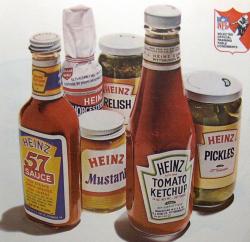Is There a Difference Between Ketchup and Catsup?

On last night’s Mad Men, Peggy (Elisabeth Moss) impressed the suits at Heinz with an advertising pitch that attacked the brand’s competitors. Those competitors, she noted, call their product catsup, rather than ketchup.
“What’s the difference between ketchup and catsup?” Peggy asked. “Well, catsup has more tomatoes, comes in a bigger bottle. It’s cheaper, but tastes just like ketchup. Now,” she continues, “we know that’s not true. But that’s what your competitors are saying, over and over. And they’re selling their watered down, flavorless sauce by pretending that they’re you. It makes you angry, doesn’t it?”* she adds.
It does. But wait a second. Is there a difference between ketchup and catsup?
No. (Rest easy, Mr. Burns.) Both are names for a sauce that once was made using a variety of ingredients, including mushrooms and walnuts, and is now primarily made using tomatoes. In his Slate piece on ketchup’s Chinese origins, linguist Dan Jurafsky notes that catsup, ketchup, and katchup (with an ‘a’) are all “old-fashioned Westernized transcriptions” of an old Chinese word for fish sauce. Heinz advertises its product as “Heinz Tomato Ketchup” probably because tomatoes weren’t added to ketchup recipes until the 19th century. (Update: See below for a comment from Heinz.) While Heinz’s “catsup” competitors may have been more “watered down” in 1968—when last night’s episode took place—the name of their supposedly inferior products did not itself indicate any differences in their recipes.
Eventually, the spelling chosen by Heinz came to dominate, probably because Heinz itself dominated the market. If you go looking on the web for information about that shift, though, you’re likely to encounter a fair bit of misinformation. According to one widely circulated account, Heinz competitor Del Monte switched over to using ketchup after the Reagan administration declared “ketchup” a vegetable for the purposes of school lunches. In this version of events, the spelling “catsup” did not appear on a list of approved vegetables. In fact, the proposed regulation in question did not mention ketchup specifically at all—it mentioned “pickle relish” as a possible vegetable, hence the condiment-related uproar—and, in any case, the proposal never came to pass. (After it was derided by the news media, which touted the ketchup storyline, the proposal was revised.) Another popular story is that Hunt’s used to market its product as ketchup west of the Mississippi, as catsup east of the Mississippi, and as tomato cornchops in Iowa. Much as we would like that last detail to be true, we have found no evidence for it.
We have, however, reached out to Del Monte and Hunt’s to find out precisely when and why both companies re-branded their products as ketchup, and we will update this post if and when we hear from them.
Update, April 22, 5:25 p.m.: According to a Heinz spokesperson, Henry John Heinz first brought his product to market as “Heinz Tomato Catsup,” but changed the spelling early on to distinguish it from competitors. And Dan Jurafsky tells us that Del Monte did not switch spellings until 1988, after it became clear that ketchup was the spelling of choice for American consumers. (Hunt’s went with ketchup significantly earlier, he says.)
Correction, April 23, 2013: This post originally quoted Peggy as saying "It makes you mad, doesn't it?"

